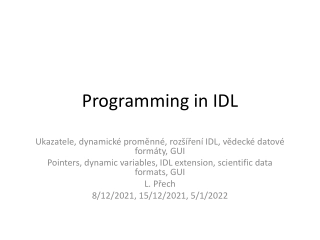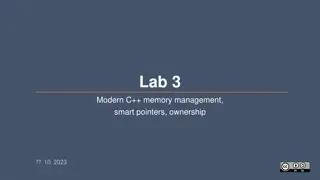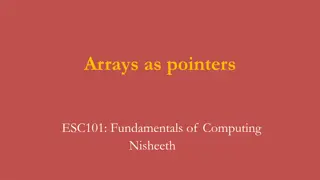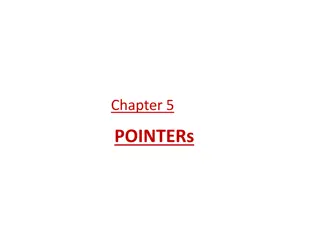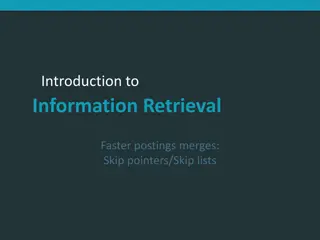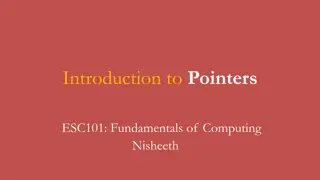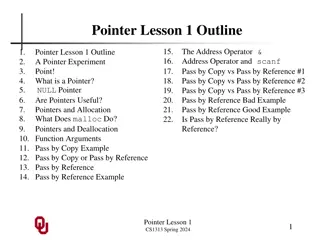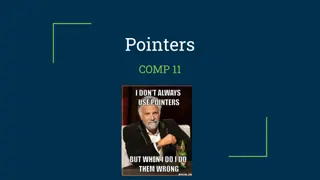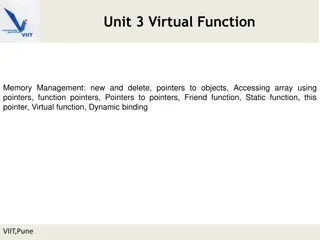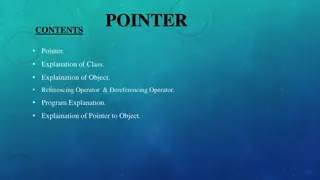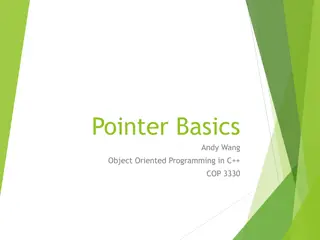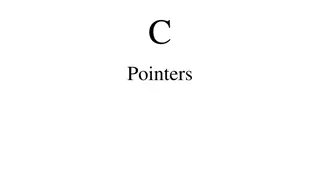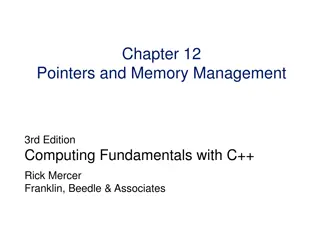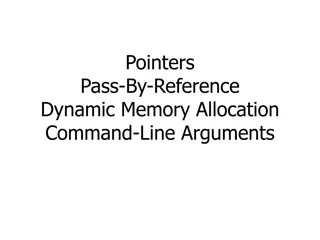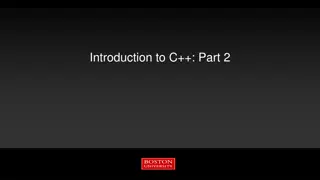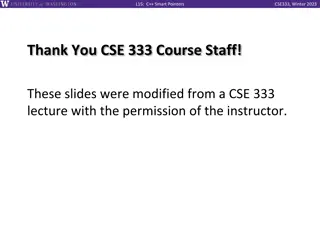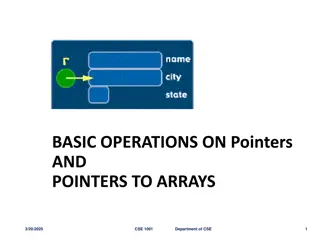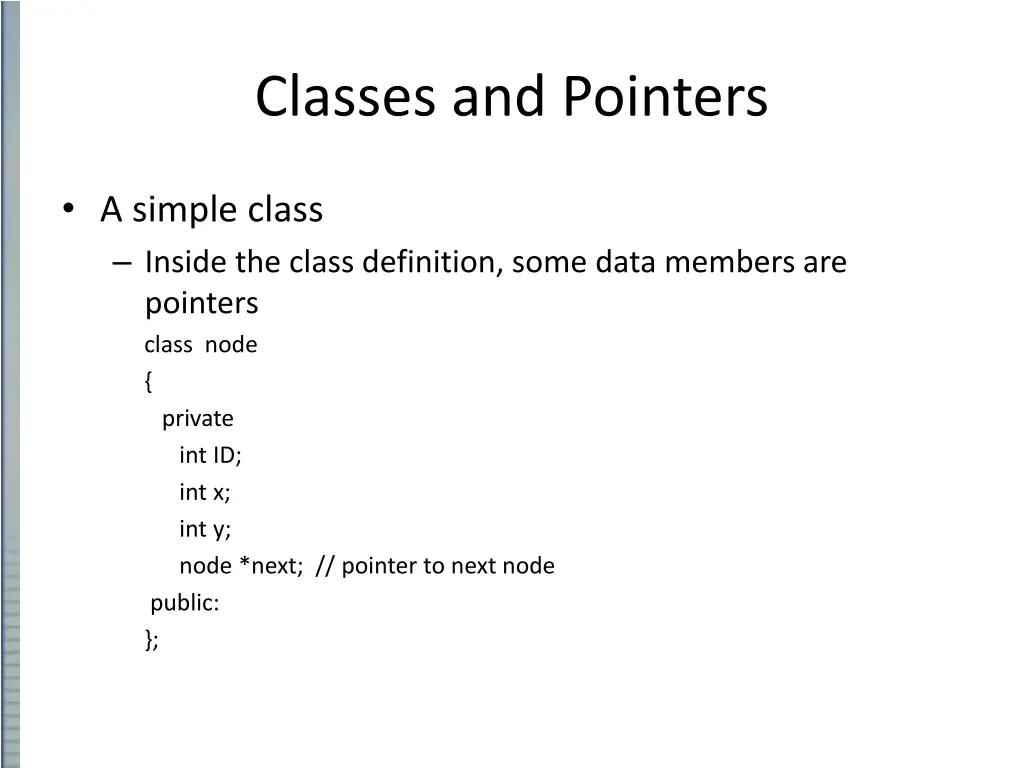
Understanding Classes and Pointers in C++
Explore the concept of classes and pointers in C++, including dynamic object creation, accessing data members, and manipulating member functions through pointers. Learn how to allocate and deallocate memory and effectively use pointers within class definitions.
Download Presentation

Please find below an Image/Link to download the presentation.
The content on the website is provided AS IS for your information and personal use only. It may not be sold, licensed, or shared on other websites without obtaining consent from the author. If you encounter any issues during the download, it is possible that the publisher has removed the file from their server.
You are allowed to download the files provided on this website for personal or commercial use, subject to the condition that they are used lawfully. All files are the property of their respective owners.
The content on the website is provided AS IS for your information and personal use only. It may not be sold, licensed, or shared on other websites without obtaining consent from the author.
E N D
Presentation Transcript
Classes and Pointers A simple class Inside the class definition, some data members are pointers class node { private int ID; int x; int y; node *next; // pointer to next node public: };
Classes and Pointers Allocating and deallocating space new returns a pointer pointing to a new object of the specified class, delete releases the space node *temp; temp = new node; delete temp; To create and destroy an array of objects node *temp; temp = new node[10]; .... delete [] temp;
Classes and Pointers A pointer to a class Exactly the same way as a pointer to a structure Access members of a pointer to a class using the member access operator -> operator With all pointers, you must initialize the pointer before using it.
Classes and Pointers Dynamic objects Use new operator Syntax to declare a pointer to an object ClassName* VariableName = new ClassName; Syntax to declare a pointer to an array of objects ClassName *VariableName[Dimension];
Classes and Pointers Pointers to member functions and data members Declaring pointers to data members Declaration : datatype class_name :: *pointer_name ; Assignment : pointer_name = &class_name :: datamember_name ; int A::*pmi; // declare pmi as a pointer to an int member of A class A { public: int num; int x; }; int A::*pmi = &A::num; //initialize pmi
Classes and Pointers Pointers to member functions and data members Manipulate a data member through objects Object.*pointerToMember ObjectPointer->*pointerToMember //can be accessed A a1; A a2; int n = a1.*pmi; // copy the value of a1.num to n a1.*pmi = 5; // assign the value to a1.num a2.*pmi = 6; // assign the value 6 to a2.num Access a data member through a pointer to A below. A * pa = new A; int n = pa->*pmi; // assign to n the value of pa->num pa->*pmi = 5; // assign the value 5 to pa->num
Classes and Pointers Pointers to member functions and data members Declaring pointers to member functions return_type (class_name::*ptr_name) (argument_type) = &class_name::function_name ; class A { public: int func (); }; int (A::*pmf) (); /* pmf is a pointer to some member function of class A that returns int and takes no arguments*/
Classes and Pointers Pointers to member functions and data members Declaring pointers to member functions A pointer to a member function looks just like a pointer to function, but it contains the class's name immediately followed by the :: operator pmf = &A::func; //assign pmf A a; A *pa = &a; (a.*pmf)(); // invoke a.func() // call through a pointer to an object (pa->*pmf)(); // calls pa->func()
Classes and Pointers This pointer An alternative to returning an object from one of its member functions Instead of explicitly declaring a variable when implementing a function that returns the same object, the compiler simply needs to know what object you want to return: the object that called the method or a newly declared one. If you want to return the same object, you can use a special pointer called this.
Classes and Pointers This pointer An alternative to returning an object from one of its member functions Every object has access to its own address through this pointer. The this pointer is an implicit parameter to all member functions. Inside a member function, this may be used to refer to the invoking object. Only member functions have a this pointer. (friend functions don t have it)
Classes and Pointers This pointer

